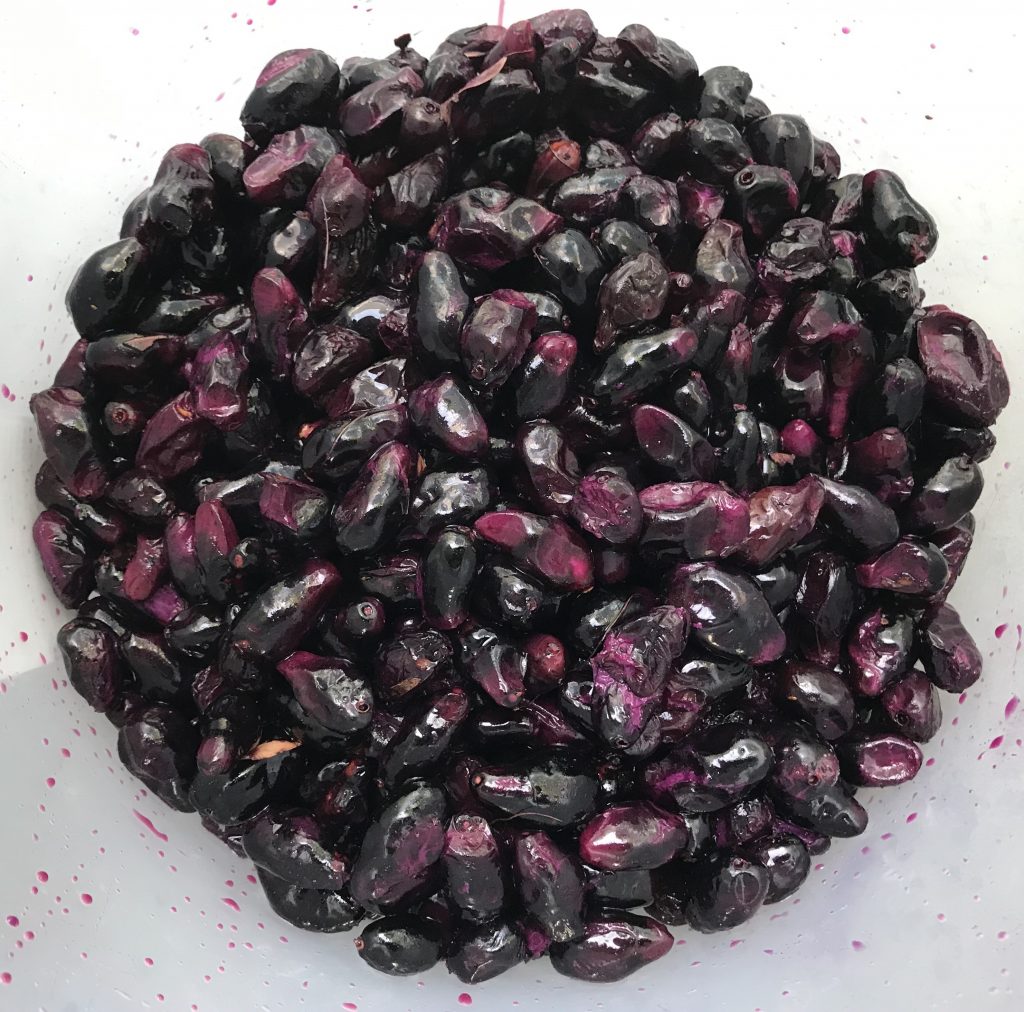
Different species of Jambul Trees produce different colored fruit. The seeds of one is cloves. Photo by Green Deane
What can be said about the Jambul Tree?
First, if you don’t like the name you can call it the Java Plum. The Indians prefer Jamun. The tree also demonstrates quite a few principles. One is that the toxin is often on the outside. Why? Because that is where insects, birds and other animals attack first. This is why green potatoes can make you sick if you eat the skins. In the case of the Jambul Tree the skin of the sweet fruit is loaded with tannin, about 10 times more than a red grape. So they are edible but there is a bitter astringency. Sprinkling with salt or soaking in salt can reduce that. More on that in a moment.
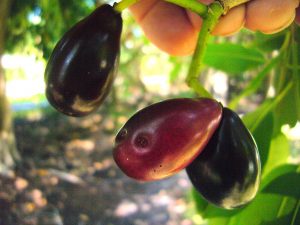
Even ripe Jambul fruit is astringent. Photo by Green Deane
Another principle being demonstrated this year is that Mother Nature rules. Last year the edible terrestrial mushroom season was off by six weeks because seasonal rains were either late or light. Last year the Jambul Trees fruited in early August. This year the rains were right on time as where the terrestrial mushrooms. And this year the Jambul Trees are fruiting now and have been. That puts them six weeks ahead of last year. Foraging includes, among many skills, watching the weather.
The major impediment to the tree — though it is a commercial fruit — is the tannins. Salt does mitigate that some when eating them fresh and is reported to lower blood glucose levels. Making wine out of the fruit is a challenge because of the tannin. Often when you make wine you have to add tannin. In this case one has to use strategies to reduce the tannin. This ranges from yeast selection to fining agents that grab onto the large tannin molecules and help them sink to the bottom so they can be left there. You can read about the Jambul Tree here.

Classes are held rain or shine though tropical storms and hurricanes are exceptions.
Foraging Classes this weekend will be warm, close to 100 degrees. Saturday is Ft. Pierce in southeast Florida, Sunday mid-east coast just north of the space center.
Saturday, June 27th, George LeStrange Preserve, 4911 Ralls Road, Fort Pierce, FL, 34981. 9 a.m. to noon. Third time is a charm. This class has had to be rescheduled twice because of weather. This is also the only location without any official bathrooms.
Sunday, June 28th, Haulover Canal, Merritt Island National Refuge, north of the Kennedy Space Center, 9 a.m. to noon. This is contingent on the park being open. I am awaiting an answer now.
Sunday, July 5th, Lake Woodruff National Wildlife Refuge, 2045 Mud Lake Road, DeLeon Springs, FL. 9 a.m. to noon if the location is open. This site is the most closed-prone. It also requires much walking so bring lots of water and be prepared to use primitive bathrooms. We meet at the first parking lot on your right after crossing the railroad tracks.
Saturday, July 11th, Dreher Park, 1200 Southern Blvd., West Palm Beach, 33405, 9 a.m. to noon. Meet just north of the science center.
Sunday, July 12th, Mead Garden: 1500 S. Denning Dr., Winter Park, FL 32789, 9 a.m to noon. Meet in the parking lot near the bathrooms. The entrance to the park is on the west side off Denning Avenue. Many GPS direct you to an old, closed entrance on the east side on S. Pennsylavania Ave.
To read more about the classes, to pre-pay or to sign up go here (And a couple of favors. If anyone knows if the bathrooms in Dreher Park are open please let me know. And are the port-o-lets still at the Gainesville parking lot at the Hawthorne Trail at Boulware Springs? Can’t hold classes where there aren’t open bathrooms. Thanks.)
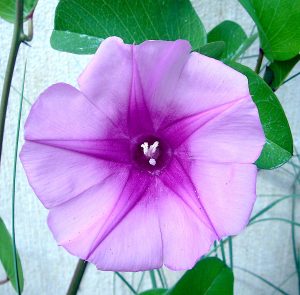
Pink Morning Glories are iffy. Photo by Green Deane
After about 40 years of foraging I was organizing my Morning Glory information one day. Some are edible, some are famine food — eaten now and then or in small quantities. A few are mind altering. I did not have a flash of brilliance but one of color. Species of Morning Glories with blue blossoms are usually not edible, often they can make you ill while simultaneously getting you high by having the LS part of LSD. Species of Morning Glories with pink blossoms are usually not edible and or are a famine food, kind of 50/50 thing, some edible in small amounts for a while, some not edible at all. They also tend to be coastal or ornamental. And I ignore small white Morning Glory blossoms or small white Morning Glories with a ruby throat. They might have a bit of cyanide in them, such as the Alamo Vine. However… large white Morning Glory blossoms or large white Morning Glory blossoms with a ruby throat usually have something edible. Large in this case means blossom at least three to four inches long or longer. Which part is edible with big white blossoms depends upon the species. It might be the blossom, leaves, root, or the entire plant. With this rough guide you can glance at a Morning Glory blossom and know whether to inquire further. To read more about Morning Glories go here.
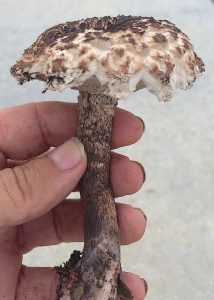
Old Man of the Woods is also an edible Bolete. Photo by Green Deane
It has to be the rhythm… A song by the group “America” has been on my mind of late. The lyrics are “I’ve been through the desert on a horse with no name.” Except I hear “I’ve been cookin’ in the kitchen with a Bolete with no name…” There are seven Gyroporus mushrooms in North America. I see two regularly: G. castaneus (the Chestnut Bolete) and G. subalbellus, the nameless Bolete. The Chestsnut Bolete, however, is well-named. The cap has a nice rich chestnut color. And of course as a Bolete it does not have gills but rather pores. It does not stain when bruised and usually has a hollow stem. It’s the other one I have eaten several of thus far this year, G. subalbellus. It has a pale cap, buff, yellowish, pinkish. It’s pore bruise slowly to pink. There is often pink on the stem which is bulbous at the base and usually partially hollow. They both have a good flavor and texture. Unless you’re an advanced mushroom hunter you can use the following rules to eliminate any Boletes that might make you sick (not counting for the wild card of allergies.) Do not eat any Boletes with pores that are red or orange, do not eat any Boletes with an orange cap, do not eat any Boletes that stain blue or green. Do not eat any bitter Boletes. There are some edible blue staining Boletes but that is a more advanced challenge.
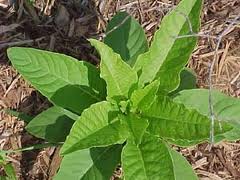
Poke leaves must be cooked before eaten. Photo by Green Deane
When is a salad not a salad? When it’s poke sallet. Though they sound the same (both pronounced “salad” and spelling can vary) the one in English means raw greens. The other in French means cooked greens. Unfortunately a popular song in 1968 spelled it the wrong way on the record label and people have been getting sick ever since. (In fairness in the song the lyrics say Annie cooked the greens. She was so poor that was all she had to eat.) Pokeweed has to be cooked, preferably boiled at least twice in two changes of water. In fact I got a message this week from a writer who thought poke sallet meant salad and got ill from eating a salad of raw poke leaves. Don’t do it. This brings up another aspect of pokeweed. People ask me if boiling it twice reduces the nutrition. The answer is hardly at all. The only vitamin pokeweed has is vitamin A. That is a fat soluble vitamin. Boiling it doesn’t have much effect on the vitamin A content. Also, boiling the poke weed carries away the toxins and makes the magnesium in the green chlorophyl more available. Cook your poke! My videos on Poke Weed are here and here. To read more about pokeweed, go here.
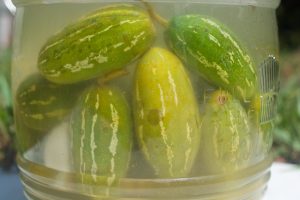
Fermenting Ivy Gourds/Tindora. Photo by Green Deane
Part of foraging for wild food is also preserving it. As the Ivy Gourd is a prolific producer — featured two weeks ago in this newsletter — what to do with all its stubby cukes is a challenge. A lot of them go into salads, and many become pickles as pictured above. Lacto-fermenting is easy and a traditional way to preserve a wide variety of food. It works well with the Ivy Gourd because it soften their skin which is slightly tough. The basic fermenting process could not be simpler. The “pickles” above were made by putting them unwashed in a jar with a pint of water and two tablespoons of sea salt. You then partially fill a plastic baggy with water to put on top of the gourds to assure they are totally covered with the solution and there’s no air space. Cover and wait a few days, no need to refrigerate. The high salt content in the water inhibits bad bacteria but encourages the right bacteria. Within a few days to a couple of weeks — usually just days — you have pickles and they’re probiotic. Not only have I planted this food-producer in my backyard but I have found three more in the wild near where I found this one originally. I think they might come home with me this fall. You can read more about the Ivy Gourd here.

Green Deane videos are now available on a USB.
Changing foraging videos: My nine-DVD set of 135 videos has been selling for seven years. They are the same videos I have on You Tube. Some people like to have a separate copy. The DVD format, however, is becoming outdated. Those 135 videos plus 15 more are now available on a 16-gig USB drive. While the videos can be run from the DVDs the videos on the USB have to be copied to your computer to play. They are MP4 files. The150-video USB is $99 and the 135-video DVD set is now $99. The DVDs will be sold until they run out then will be exclusively replaced by the USB. This is a change I’ve been trying to make for several years. So if you have been wanting the 135-video DVD set order it now as the price is reduced and the supply limited. Or you can order the USB. My headache is getting my WordPress Order page changed to reflect these changes. We’ve been working on it for over three weeks. However, if you want to order now either the USB or the DVD set make a $99 “donation” using the link at the bottom of this page or here. That order form provides me with your address, the amount — $99 — tells me it is not a donation and in the note say if you want the DVD set or the USB.

Green Deane Forum
Want to identify a plant? Perhaps you’re looking for a foraging reference? You might have a UFO, an Unidentified Flowering Object, you want identified. On the Green Deane Forum we — including Green Deane and others from around the world — chat about foraging all year. And it’s not just about warm-weather plants or just North American flora. Many nations share common weeds so there’s a lot to talk. There’s also more than weeds. The reference section has information for foraging around the world. There are also articles on food preservation, and forgotten skills from making bows to fermenting food.
This is weekly newsletter 411, If you want to subscribe to this free newsletter you can find the sign-up form in the menu at the top of the page.
To donate to the Green Deane Newsletter click here.

